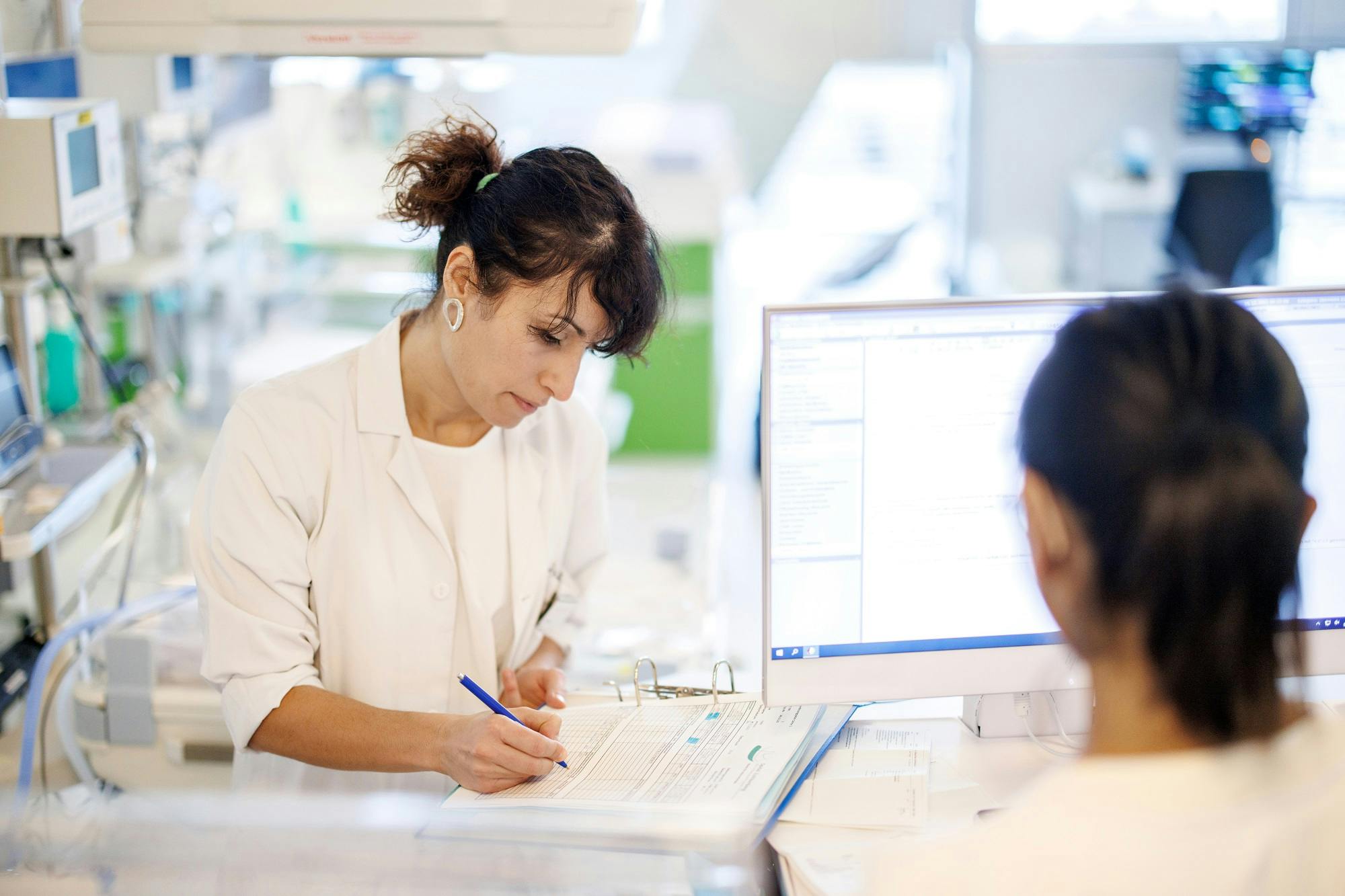First aid: Do you know what to do in an emergency?
January 30, 2023
15 min
A study commissioned by the Swiss Red Cross (SRC) and Helsana in 2020 shows that the Swiss population is very willing to provide first aid: The willingness of the Swiss population to provide first aid is high, but the knowledge of every second person surveyed is not sufficient. On average, the last first aid course was 15 years ago. Most Swiss people take such a course when they learn to drive - over time, their knowledge deteriorates. But emergencies happen suddenly. This makes it all the more important to know how to react correctly.
Anyone who has to resuscitate people because their heart has stopped beating must perform chest compressions. You can play a music track in your head as a rhythm aid. Do you know which one?
- Stayin' Alive by the BeeGees
- Beat It by Michael Jackson
- Don't Go Breaking My Heart by Elton John and Kiki Dee
"Stayin' Alive" has between 100 and 120 beats per minute - the perfect rhythm for a cardiac massage. How do you do it? Simply pressing helps: vertically on the centre of the chest 6 cm deep at a frequency of 100 times per minute. Even better: after pressing 30 times, hold your nose closed with your fingers and blow air into your mouth twice until your chest rises. Continue this process (30 presses, 2 breaths) alternately until the patient is breathing or help arrives.
The contents of a first aid course also include haemostasis and pressure dressings. What should you do if the pressure bandage is soaked with blood?
- Replace the old pressure bandage with a fresh one.
- Apply a second pressure bandage over it.
- Do not change anything and wait until the emergency services arrive.
The pressure bandage should stem the loss of blood. If the old dressing is removed, two problems could arise: Dirt could get into the wound and already encrusted blood could be torn away again, which would increase the blood flow again.
An unconscious person lies at the scene of an accident. Breathing must be checked by sight, hearing and touch. How much time should you invest in order to determine (with a high degree of probability) whether the person is breathing?
- Breathing is checked for a maximum of 10 seconds.
- Breathing is checked for a maximum of 15 seconds.
- Breathing is checked for a maximum of 20 seconds.
Breathing is checked for a maximum of 10 seconds. To check this, the airways are cleared by tilting the head backwards and lifting the chin at the same time. In this position, breathing is checked by sight, hearing and touch: See if the chest rises and falls. Place your ear over the patient's mouth and nose and listen for breathing sounds. Use the cheek to check whether the person's airflow can be felt.
A healthy person has 4 to 6 litres of blood in their body. In the event of severe bleeding, a large amount of blood is lost in a very short time. The loss of blood can quickly lead to a so-called shock. What percentage of blood can a person lose before they run the risk of going into shock?
- 10 per cent
- 20 per cent
- 35 per cent
A person can still compensate well for a loss of approx. 20 percent (about 1 litre of blood) and the arterial blood pressure remains normal. If the loss exceeds 20 per cent, there is a risk of developing shock. In this state of shock, the ratio of blood volume to vascular volume is no longer correct, so that the body switches to an emergency programme.
One inattentive moment - and it has happened. An electric knife has severed a finger. What is the best way to transport it to hospital so that the doctor can reattach it?
- On ice: the colder the severed finger is transported, the better.
- Wrap the severed finger sterilely, then pack it in a plastic bag and transport it to the hospital at room temperature.
- Wrap the severed finger sterilely, then place it in a plastic bag and store it in cool water until it reaches the hospital.
The severed part of the body is wrapped sterilely. Then place it in a transparent plastic bag. A second bag is placed over this. Only this bag is filled with cool water, in which a few ice cubes may also float. However, this should not only contain ice. The severed body part should therefore be cooled during transport, especially in warm temperatures, but not too cold. Otherwise crystals will form in the cells, causing them to burst. The tissue dies. Direct contact with water is also harmful, as it causes the tissue to swell.
In which situation do you perform the "recovery position"?
- If unconscious and still breathing adequately
- In the event of shock
- If unconscious and not breathing
If the victim is unconscious and breathing, they are placed in the recovery position. The aim is for the victim's mouth to become the lowest point of the body so that any vomit and blood can drain away and not enter the airways.
A motorcyclist has fallen in a road accident, is lying on the ground and is unconscious. He is wearing his helmet. What should first aiders do with it?
- Take it off in any case
- Leave it on in any case
- Only remove the helmet if it seems necessary - for example, if the injured person is no longer breathing or has vomited
In the case of an unconscious motorcyclist, it is necessary to remove the helmet, as only then can proper positioning (if breathing is possible: stable lateral position) be carried out.
A woman appears anxious, she is pale, gasping for air and has to sit down. When asked, she reports severe pain radiating into her right arm and an enormous feeling of pressure in her chest. The assumption: heart attack. But does that match the radiating pain?
- That fits very well, a heart attack always radiates to the right arm.
- No, a heart attack always radiates to the left arm.
- A heart attack can radiate into both the right and left arm and further into the upper jaw, back or abdomen.
Although the pain of a heart attack more often affects the left arm, it can also radiate into the right arm, both arms or into the back, neck or upper abdomen. The woman's other symptoms are also consistent with a heart attack: those affected often have shortness of breath and a strong feeling of tightness or pressure in the chest. There may also be stabbing, burning or pressing pain behind the breastbone or nausea. It is important not to hesitate if you suspect this, but to call an ambulance immediately.
To signal an accident or breakdown, a breakdown triangle must be placed at the side of the road in front of the affected area. But where exactly?
- In urban areas 20 m, out of town 50 m before the accident site
- In urban areas 50 m, out of town 100 m before the scene of the accident
- In urban areas 100 m, out of town 150 m before the scene of the accident
In the event of a breakdown in or out of town, you should pull over immediately and switch on the hazard warning lights at the same time. The breakdown triangle must be positioned 50 metres behind the vehicle in urban areas and up to 100 metres behind it in rural areas, of course in such a way that it can be seen from a distance.
The Swiss emergency numbers are 144 for the emergency doctor, 117 for the police and 118 for the fire brigade. Which number do you dial if you need to report an emergency anywhere in Europe?
- 112
- 122
- 121
Save this emergency number on your smartphone.
0/0
Weitere Beiträge
Counsellor
Understanding panic attacks: What triggers them and how to counter them
Panic attacks are like sudden storms in the soul - they strike unexpectedly, unleashing a wave of intense fear and often leaving confusion and uncertainty in their wake. But what exactly is a panic attack, how are they diagnosed and treated, and what can sufferers do to deal with them? To delve deeper into this topic, we spoke to Dr Ruedi Schweizer, Medical Director of our Centre for Mental Health.
Counsellor
Can psycho-oncological support improve the chances of recovery or the quality of life of breast cancer patients?
In psycho-oncological topics, you and your relatives will be accompanied through all phases of the illness by experienced psychologists specialising in psychotherapy and specialists in psychiatry and psychotherapy. In this way, we can provide relief, give courage and open up new perspectives. Dr Ruedi Schweizer, our expert in psycho-oncology and Medical Director of the Centre for Mental Health, explains in the following video.
Counsellor
Focus on women's health: An interview with Dr Julia Graf, specialist in gynaecology and obstetrics
On International Women's Day, we would like to focus on women's health. To this end, we met with Dr Julia Graf, an experienced specialist in gynaecology and obstetrics and senior physician at the Women's Clinic, to talk about various aspects of women's health.


